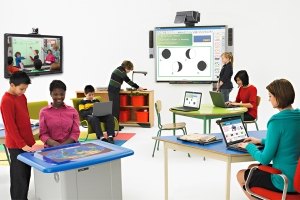Class timing
|
- Schedule is fixed and pre-decided. Students and teachers have little say in this decision.
|
- Schedule can be flexible, according to the needs of both teacher and students.
|
- Class duration is fixed and usually not extendable, as the next class waits to use the classroom.
|
- Class duration is easily extendable, instructor and student time permitting.
|
- While extra classes can be scheduled, they’re often impractical and usually result in low attendance
|
- Schedule extra classes at your convenient time and study from the luxury of home.
|
Learner groups
|
- Students can be a homogenous group, sharing overlapping social circles and customs.
|
- Students can be a heterogeneous group, even global, with a variety of non-intersecting (and perhaps conflicting) social circles and customs.
|
- Students typically fall within a similar age, profession, or academic background.
|
- Student composition may vary greatly in age, profession, and academic background.
|
Teaching methodology
|
- Classes are typically teacher–driven and teacher-centric.
|
- Classes can be technology-driven and learner-centric, with the teacher as a facilitator. Teachers have better teaching tools to effectively engage learners. Virtual classrooms allow students more freedom to create, experiment, explore and steer the class. This freedom can produce improved student performance.
|
- Traditional teaching tools are used, such as lecture notes, charts, blackboard writing, showing physical models, laboratory experiments, etc
|
- Modern teaching tools are used, such as multimedia, animation, 3D modeling, virtual, etc.
|
- Learning environment can be dull and fun in class is kept to a minimum to avoid disciplinary issues.*
|
- Learning environment can be stimulating and fun. Moderation tools allow the teacher to easily control the class, just in case things get out of hand!
|
Collaboration in learning
|
- Teacher and students collaborate in the physical classroom.
|
- Teachers and students collaborate online via audio, video, and text chat.
|
- It’s hard to address the needs of different levels of learners in a single class. If there aren’t additional resources available for groups such as slower or gifted students, they often have to make do with a one-size-fits-all average class.
|
- It’s easier to work with different learner types. Divide a single virtual classroom into breakout sessions, and let students of different levels work at their own pace, while the teacher moderates and facilitates.
|
- Usually one teacher per class. Difficult to bring in guest speakers due to physical and travel constraints.
|
- Easier to involve multiple teachers, and to bring in guest speakers from anywhere in the world.
|
- Mostly single subject learning due to space and scheduling constraints.
|
- Inter-disciplinary and off-beat subjects easy to teach and learn, thanks to lack of space and fewer scheduling constraints.
|
Evaluation
|
- Evaluation involves taking tests, and handing in manually-graded assignments. Time-consuming and results are slow.
|
- Automated evaluation conducted through online tests. Results are quick, accurate, and completely transparent. Generate feedback through online polls and immediate results so that further class learning is steered accordingly.
|
Recording
|
- Class is held, and if you forget to note something down or can’t attend, you’ve missed it.
|
- Classes are recorded, including audio, video and even screen. Students can review the instructor’s exact explanation and methods, and administrators can review both the instructor’s and students’ performance.
|
Common distractions
|
- Common distractions include breaks, student interruptions, and administrative details.
|
- Common distractions include internet problems, and students indulging in other online activities.
|
Cost
|
- Setting up classroom infrastructure is expensive.
|
- A computer, a basic Internet connection, a headphone, and a web camera (optional) are less expensive.
|
- Buses, cars, and other travel methods have to be engaged to get students to and from school.
|
- No travel costs. Teach and learn from anywhere.
|
- Difficult for professionals to attend courses for professional development, due to work and other commitments making it impossible to find something that fits their schedule and location.
|
- Professionals can take classes from home, anytime (even late nights or early mornings). Technology Based Training (TBT) yields a time savings of 35-45% over traditional classroom instruction.
|
- Classrooms need water, electricity, etc.
|
- Virtual Classroom is green teaching, saves paper, and any other such costs.
|
- Overhead results in high fees for a course in a physical school.
|
- Classes conducted in virtual classrooms are comparatively cheaper, as much as 80% Classes conducted in virtual classrooms are comparatively cheaper, as much as 80%.
|




